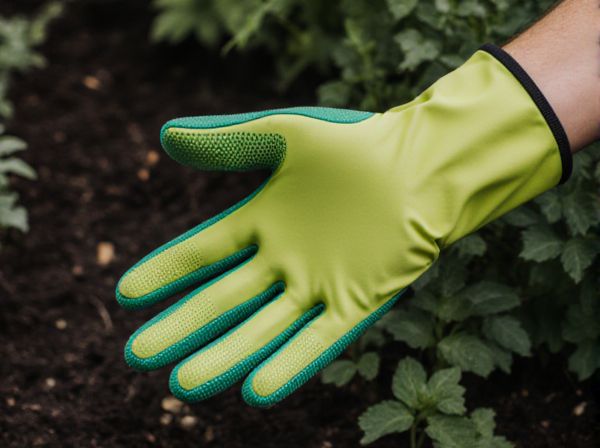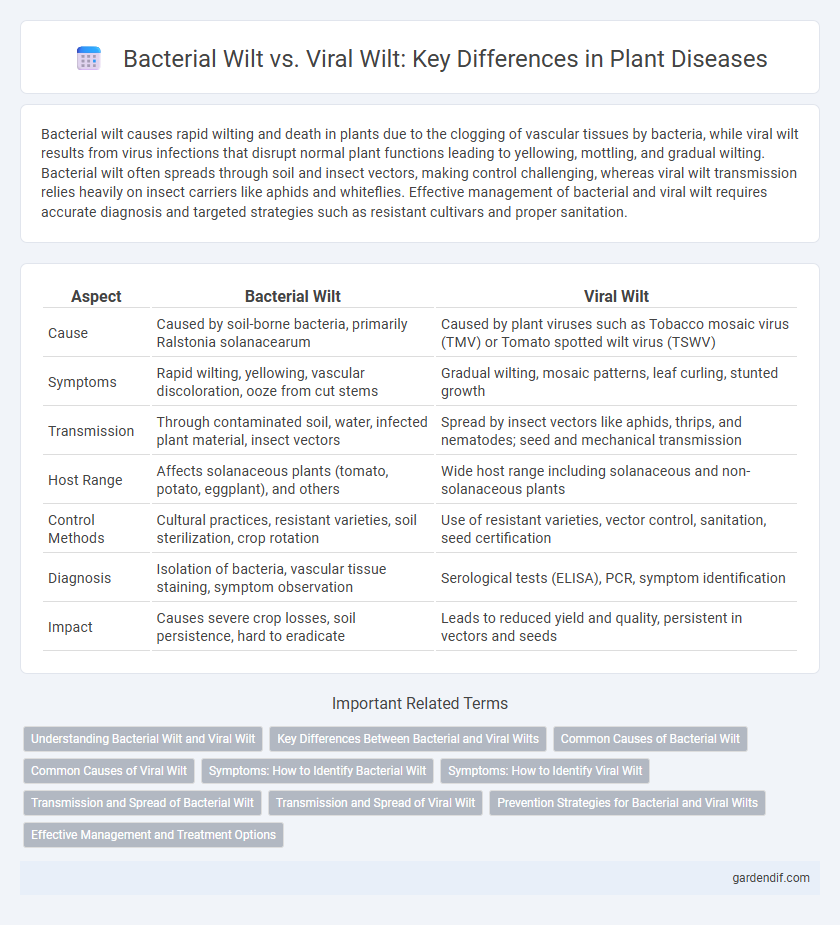
Bacterial wilt vs Viral wilt Illustration
Bacterial wilt causes rapid wilting and death in plants due to the clogging of vascular tissues by bacteria, while viral wilt results from virus infections that disrupt normal plant functions leading to yellowing, mottling, and gradual wilting. Bacterial wilt often spreads through soil and insect vectors, making control challenging, whereas viral wilt transmission relies heavily on insect carriers like aphids and whiteflies. Effective management of bacterial and viral wilt requires accurate diagnosis and targeted strategies such as resistant cultivars and proper sanitation.
Table of Comparison
| Aspect | Bacterial Wilt | Viral Wilt |
|---|---|---|
| Cause | Caused by soil-borne bacteria, primarily Ralstonia solanacearum | Caused by plant viruses such as Tobacco mosaic virus (TMV) or Tomato spotted wilt virus (TSWV) |
| Symptoms | Rapid wilting, yellowing, vascular discoloration, ooze from cut stems | Gradual wilting, mosaic patterns, leaf curling, stunted growth |
| Transmission | Through contaminated soil, water, infected plant material, insect vectors | Spread by insect vectors like aphids, thrips, and nematodes; seed and mechanical transmission |
| Host Range | Affects solanaceous plants (tomato, potato, eggplant), and others | Wide host range including solanaceous and non-solanaceous plants |
| Control Methods | Cultural practices, resistant varieties, soil sterilization, crop rotation | Use of resistant varieties, vector control, sanitation, seed certification |
| Diagnosis | Isolation of bacteria, vascular tissue staining, symptom observation | Serological tests (ELISA), PCR, symptom identification |
| Impact | Causes severe crop losses, soil persistence, hard to eradicate | Leads to reduced yield and quality, persistent in vectors and seeds |
Understanding Bacterial Wilt and Viral Wilt
Bacterial wilt, caused by Ralstonia solanacearum, invades plant vascular systems, leading to rapid wilting and plant death, commonly affecting solanaceous crops like tomatoes and potatoes. Viral wilt results from viruses such as Tomato yellow leaf curl virus, which disrupts plant cellular functions and causes stunted growth, chlorosis, and wilting symptoms. Effective disease management depends on early diagnosis, understanding pathogen-specific transmission methods, and implementing resistant crop varieties and sanitation practices.
Key Differences Between Bacterial and Viral Wilts
Bacterial wilt is caused by soilborne bacteria like Ralstonia solanacearum, leading to rapid wilting and plant death, whereas viral wilt results from viral pathogens such as Tomato spotted wilt virus, causing systemic symptoms including mosaic patterns and stunted growth. Bacterial wilt often spreads through contaminated soil and water, while viral wilt is primarily transmitted by insect vectors like thrips and aphids. Diagnosis relies on bacterial isolation and molecular assays for bacterial wilt, compared to serological tests and RT-PCR for viral wilt detection.
Common Causes of Bacterial Wilt
Bacterial wilt is primarily caused by the soilborne pathogens Ralstonia solanacearum species complex, which infects a wide range of host plants including tomatoes, potatoes, and bananas. The bacteria enter through the roots, colonizing the xylem vessels and causing blockages that lead to wilting and plant death. Unlike viral wilt, bacterial wilt is often associated with contaminated soil, water, and plant debris that facilitate pathogen persistence and spread.
Common Causes of Viral Wilt
Viral wilt is primarily caused by plant viruses such as Tomato yellow leaf curl virus, Potato virus Y, and Cucumber mosaic virus, which are transmitted by insect vectors like whiteflies, aphids, and thrips. Unlike bacterial wilt caused by Ralstonia solanacearum, viral wilt disrupts vascular tissues by invading cells and altering physiological functions, leading to leaf yellowing, wilting, and stunted growth. The spread of viral wilt is often facilitated by infected seeds, grafting, and mechanical damage during cultivation.
Symptoms: How to Identify Bacterial Wilt
Bacterial wilt causes sudden wilting and yellowing of leaves while the plant remains green initially, often accompanied by vascular discoloration visible when the stem is cut. Unlike viral wilt, bacterial wilt produces a sticky, bacterial ooze that can be exuded from the vascular tissue when the stem is squeezed. Early identification relies on observing these symptoms along with rapid plant decline without the mosaic patterns typical of viral infections.
Symptoms: How to Identify Viral Wilt
Viral wilt is identified by symptoms such as chlorotic and necrotic leaf spots, mosaic patterns, and general leaf distortion, contrasting with bacterial wilt's sudden wilting without leaf spot development. In viral wilt, plants often exhibit stunted growth and leaf curling, whereas bacterial wilt causes rapid tissue browning in vascular systems. Accurate identification relies on observing these distinct symptom patterns and conducting laboratory tests for viral pathogens.
Transmission and Spread of Bacterial Wilt
Bacterial wilt, caused by Ralstonia solanacearum, primarily spreads through contaminated soil, water, and infected plant material, including roots and stems. The pathogen enters plants via wounds or root tips and can move systemically through the vascular system, leading to rapid wilting and plant death. In contrast, viral wilt is transmitted mainly by insect vectors such as aphids or whiteflies, facilitating virus movement between host plants.
Transmission and Spread of Viral Wilt
Viral wilt is primarily transmitted through insect vectors such as whiteflies and aphids, which feed on infected plants and spread the virus to healthy ones. Unlike bacterial wilt, which often spreads through contaminated soil or water, viral wilt dissemination heavily relies on these living carriers to facilitate rapid infection. This mode of transmission enables viral wilt to affect crops on a wider scale, often leading to significant agricultural losses.
Prevention Strategies for Bacterial and Viral Wilts
Effective prevention of bacterial wilt involves crop rotation with non-host plants, soil solarization, and the use of resistant cultivars to minimize the presence of Ralstonia solanacearum in the soil. Viral wilt prevention focuses on controlling vector populations, such as whiteflies or aphids, through insecticides and implementing virus-free planting materials to reduce infection rates. Sanitation measures like removing and destroying infected plant debris play a critical role in managing both bacterial and viral wilt pathogens.
Effective Management and Treatment Options
Effective management of bacterial wilt involves crop rotation, resistant varieties, and soil sterilization to reduce pathogen load, while chemical treatments like copper-based bactericides offer limited control. Viral wilt requires controlling vector populations, such as aphids or whiteflies, and using virus-free planting material alongside resistant cultivars for sustainable disease suppression. Integrated pest management combining cultural, biological, and chemical strategies enhances overall control efficacy for both bacterial and viral wilt diseases.
Bacterial wilt vs Viral wilt Infographic

 gardendif.com
gardendif.com